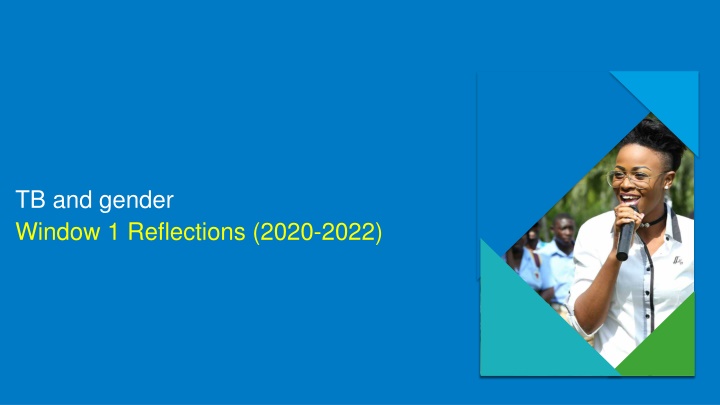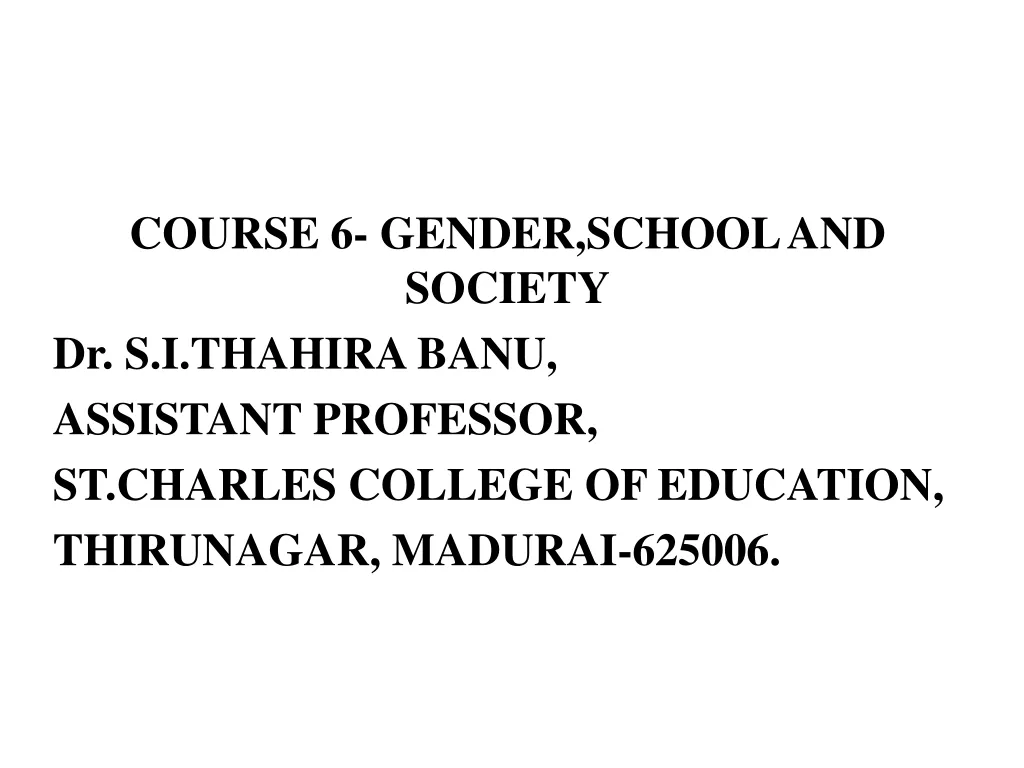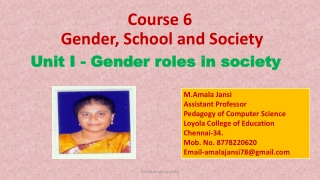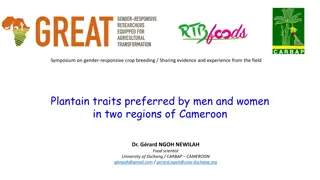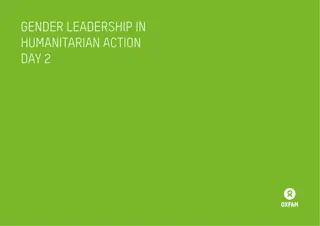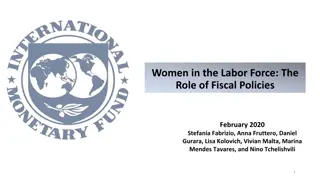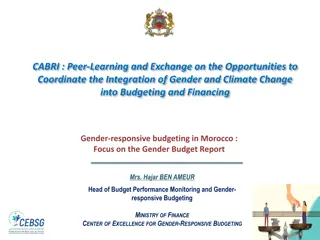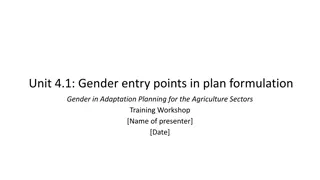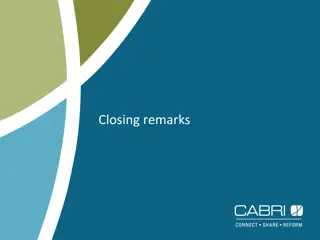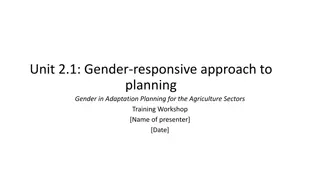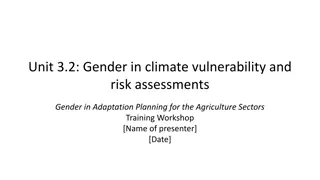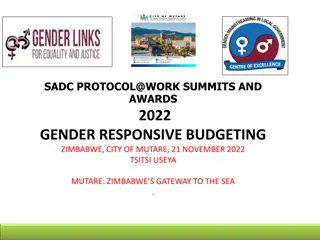Gender-Responsive Strategies for TB Program Improvement
The reflections highlight gaps and improvement areas in reaching men and key populations in TB programs, emphasizing the need for gender-specific approaches, community-based services, and integration of gender considerations in funding requests.
Download Presentation

Please find below an Image/Link to download the presentation.
The content on the website is provided AS IS for your information and personal use only. It may not be sold, licensed, or shared on other websites without obtaining consent from the author.If you encounter any issues during the download, it is possible that the publisher has removed the file from their server.
You are allowed to download the files provided on this website for personal or commercial use, subject to the condition that they are used lawfully. All files are the property of their respective owners.
The content on the website is provided AS IS for your information and personal use only. It may not be sold, licensed, or shared on other websites without obtaining consent from the author.
E N D
Presentation Transcript
TB and gender Window 1 Reflections (2020-2022)
Window 1 Reflections Some gaps and areas of improvement Reaching Men. No clear approaches/strategies for reaching men who disproportionately have poorer TB diagnostics and treatment outcomes. This could include: Gendered outreach programs and work place programs ATB Stigma Index or Patient Care Pathway Survey incorporating gender issues A more comprehensive engagement of private care providers in TB case finding, treatment, care and systematic notification of cases Community mobilization to address harmful gender norms such as a 'males champion program Reaching KPs. While KPs may be identified in the national strategy and FA, strategies and programs are not clear (i.e. for slum dwellers and nomadic people; migrants; etc.). This should include approaches like: Gender specific stigma reduction and know-your-rights messaging in advocacy campaigns, trainings and communication materials, Integrating medical ethics and gender equality principles in TB trainings for both health facility staff as well as community health workers. Developing a community-based monitoring system and related tools Further expanding community-based service provision that responds to the gender dynamics exposed through the data Strengthening gendered approaches, including in CSS Approaches. This could include: Integrating the referral of patients to social services providers, such as centers of social services for family, children and youth, social services institutions and NGOs, to receive aid for both patients and their families Community based monitoring to improve service delivery quality, ensuring the ability of women and KPs to participate Strengthening the capacity of community based NGOs to do case finding, adherence support, etc. Integration of TB, HIV and Malaria in the TORs of government hired community health providers and their training on the three diseases
Key priorities - all funding request should include: 1. Addressing equity through better programming and targeting relies on better data use for prioritization of sub-population and geographic focus, including qualitative data to understand and respond to gender and rights-related risks and barriers to TB services. 2. Comprehensive programs to address human rights and gender-related barriers to access to and uptake of services is a priority, and should be integrated into packages for key and vulnerable populations, as well as programs for strengthening health and community systems. 3. Support for community systems strengthening, including community-based monitoring and with a focus on nascent, community groups and key population led groups, e.g. TB-affected communities, PLHIV-led, sex workers-led and networks to enable effective delivery of programs and advocacy. 4. Meaningful engagement of CSOs throughout the grant lifecycle & related policy process 3
Integrating gender-related considerations into the funding request Yes Use data to inform service delivery approaches Epi context explained w/ sex disaggregated data? No Include data collection, analysis and capacity strengthening under the RSSH module: Health information systems and M&E. Ensure interventions addressing affected populations/sub- population (by gender) are included in the proposed programs, with adequate budgets Yes Does the sex- disaggregated data reveal inequity by age/gender*? Describe gender and other barriers to accessing services, including for boys/men girls/women and how these are resolved in the proposed interventions No Ensure adequate coverage levels of critical service package for key populations that considers absorption and implementation capacity Yes Are there reliable size estimates available for key populations? Include IBBS, qualitative/needs assessments other survey instruments in the funding request in the HMIS module No *in new infections (incidence), prevalence, diagnosis, treatment access, knowledge of disease transmission, morbidity, mortality, treatment completion, and other key indicators? 4 Adapted from: GF Technical Brief: Gender Equity, 2019
Scaling up defined, evidence-based comprehensive programs 7 key programs for HIV & TB + 3 specific to TB Malaria Assessing inequities, human rights and gender-related barriers Meaningful participation of affected populations Strengthening of community systems for participation in malaria programs Programs to monitor and reform laws, regulations and policies relating to malaria prevention and control Specific program approaches to address inequities and remove rights and gender- related barriers, as part of malaria module interventions (barriers to ITN, IRS, IPTp, case management) 1. Stigma and discrimination reduction 2. Sensitization of health care workers on medical ethics & human rights 3. Training of law-makers and law enforcement officials 4. Reducing discrimination against women in the context of HIV and TB 5. Legal/rights literacy 6. HIV and TB-related Legal services 7. Monitoring and reforming policies, regulations and laws relating to HIV and TB 8. Ensuring confidentiality and privacy within TB services Mobilizing and empowering patient and community groups 10. Rights and access to services in prisons and other closed settings 9. 5
TB Modular Framework Human Rights Indicators Outcome TB O-7 Number of people with TB who experienced self-stigma due to their TB status that inhibited them from seeking and accessing TB services in the last 12 months Gender (female, male) CSS Indicators Outcome TB O-8 Number of people with TB who experienced stigma in health care settings due to their TB status that inhibited them from seeking and accessing TB services in the last 12 months Gender (female, male) Outcome TB O-9 Number of people with TB who experienced stigma in community settings due to their TB status that inhibited them from seeking and accessing TB services in the last 12 months Gender (female, male) 6
